Student Blog
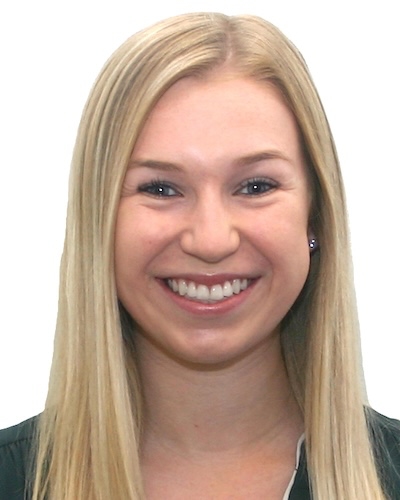
So . . . What Is OT? ⟩
February 21, 2019, by Jessica P.
So you like help people find jobs? Is it basically the same thing as physical therapy? These are just two of the questions you may be hearing a lot when you tell people that you are studying occupational therapy. As relatively youthful profession, I mean we are only 102 years old, occupational therapy is not always well known and represented in society or healthcare professions. Many people make assumptions about what we as OTs do and as an OT student I love that I get a chance to teach others about this amazing profession and the role that it can play in so many people’s lives.
Over the years, I have gotten pretty good at my “OT elevator pitch.” This is just a quick way to describe occupational therapy to someone who may have never even heard of the profession before. In one of our courses, OT 523: Communication Skills for Effective Practice, we even had the opportunity to develop our elevator pitches and get feedback from classmates. Being able to confidently share about my profession allows me to explain the unique occupational therapy lens, advocate for my future patients on why they may need OT, and educate others on a profession they may be interested in pursuing.
So . . . what is OT?
Occupational therapy is a holistic, healthcare profession which helps people of all ages and abilities do the things they need to do and want to do in their day to day lives. An occupation is not just your job, it is anything you do that occupies your time.
Across the lifespan, our occupations will obviously look different. When I was 2 months old, my main occupations were sleeping and eating. Now at 22, my occupations look very different — attending class, hanging out with friends, and working. As I get older, my occupations will again shift and look different. Occupational therapists come in when there is something that prevents you from living your life to the fullest, the way you want to. This could be from anything, such as a mental illness or physical disability.
So . . . where do OTs work?
The short answer to this is OTs work pretty much everywhere. Occupational therapists can be found working in hospitals, private clinics, schools, home health, corporations, community centers, psychiatric hospitals, skilled nursing facilities, university medical and research centers . . . and more!
After years of explaining to people that I want to be an occupational therapist, I’ve found it’s best to make it relatable to them. Ask someone “What is your favorite thing to do?” and “How would you feel if you could no longer do this?” Voila! That is where occupational therapy will come in.
⋯
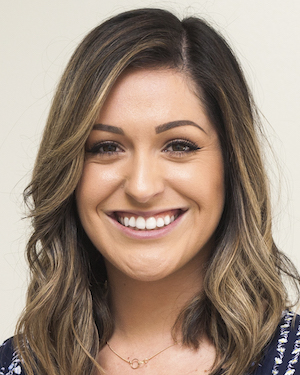
Senioritis . . . Senioritis Everywhere ⟩
February 20, 2019, by Melissa
Hey everyone! This is our last semester in the program, and things definitely haven’t slowed down. As a result, I’ve realized that a common theme amongst our class is exhaustion and senioritis. After I graduated from undergrad, I thought that senioritis was a thing of the past, but boy oh boy was I mistaken. Don’t get me wrong, I’m still enjoying my time in the program tremendously, and taking electives this semester keeps things interesting, but I am also feeling the burnout. Thus, I wanted to share some of the things that help to keep me going!
Clinical opportunities and seeing OT in action
Although there is no Level 1 fieldwork associated with our Spring Semester, we still have the opportunity to shadow OTs in specific settings depending on the electives we choose to take. I talk more in depth about these opportunities in my previous blog post, so check it out if you’d like to learn more. Getting the information we need during class is always great, as our professors are incredibly knowledgeable and they are experts in their given area of study, but there’s something invigorating about being able to see it play out in a clinical setting. For example, we learn all about the difficulties associated with treating medically fragile patients up the hill at Keck Hospital, but having the opportunity to see what that looks like is hugely beneficial to my learning. It also helps to remind me why I chose to be in this profession, as the OTs we shadow are GREAT at what they do, and the patients truly appreciate them.
Meeting with my Mentor
USC does a great job of providing us with opportunities for mentorship, and we are often encouraged to seek out faculty or staff that we think would offer mentorship in an area we are interested in. I myself have sought mentorship from several faculty and staff members, and I can happily say that we are still in contact today. However, apart from being encouraged to approach mentorship on our own, our program actually assigns us a mentor depending the area of study we’d like to pursue! I personally love the mentor I was assigned, and I am truly grateful that clinicians, faculty, and staff all take the time to mentor us. Things aren’t always going to be rainbows and sunshine, and having someone that I can go to when things get rough is truly comforting.
In addition, I have been lucky enough to work alongside 2nd year and OTD students throughout my time in the program, and they have provided great mentorship as well. As students who are ahead of you in the program, they can offer some great information on what to expect, and even some tips based on their own experiences! I’ve found it really beneficial to have a student perspective as well. Ultimately, seeking mentorship from leadership within the program or students that are ahead of you will help to ease your anxiety, and it can help with your own career planning!
Assisting with interviews for the incoming Ambassadors
This has been a particularly fun experience, as it reminds me that not too long ago I was also going through this process and hoping to be a part of the Ambassador team! It was so refreshing to see the passion, commitment, and talent in our program, and we had some very strong candidates. This position is something I knew I wanted to pursue even before I started in the program, therefore interviewing the incoming ambassadors reminded me of the excitement and NERVES that surround the application process. Now that my time as an ambassador is nearing its end, the interview process has prompted me to reflect on everything we’ve done, and all that we’ve accomplished these past months. It’s easy to get wrapped up in the chaos of everyday life, therefore taking a step back to appreciate these last two years has helped me get the energy to push through the last couple of months in the program.
Admitted Student Reception
For those that don’t know, there is an Admitted Student Reception that we host in the spring to welcome all of our admitted students. It’s such an exciting, emotional, and invigorating experience, and serves as a great opportunity to meet your future classmates and professors! I personally had such a great time, and getting to experience it again last year and this year reminds me of the excitement surrounding our admission into the program! Working the event and meeting the newly admitted class is so fun, and I find it hard to believe that my time as a Master’s student is almost over. It’s a surreal feeling, but it serves as a reminder to enjoy the time I have left!
Ordering our regalia for Graduation!
We were recently notified that we could begin to order our regalia and sashes for graduation! Although graduation is a little over 2 months away, it’s exciting to begin to plan for it. It definitely makes it feel more real, and it’s a reminder that we’re so close to the finish line. We also get to personalize our sash if we want to, which makes the process more fun! Because this semester has been so busy, it’s hard to remember that it’s not an ordinary semester, but our last one! Even that small reminder has been enough to excite me to push through the rest of the semester and finish strong.
Being tired and feeling burnt out is not a bad thing. It’s just a sign that you’ve been working really hard for a while! However, it is important to take some time to reflect and remember why you started. It’s crazy to think about how quickly my time in the program has gone by, and I’m excited to push through these upcoming months to walk the stage with my classmates!
⋯
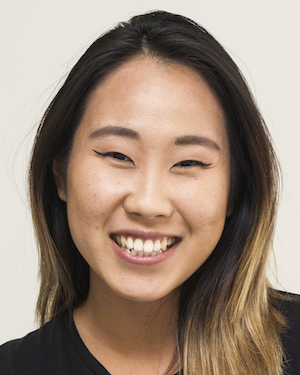
#socialmedia ⟩
February 12, 2019, by Joyce
Have you ever wondered who manages the Chan Instagram and Facebook profiles? How about our Twitter and YouTube handles?
Did you even KNOW we have those platforms? Many people get access to our channels, accounts, and platforms. But it’s been a great joy and opportunity to take the lead on a majority of the content that gets posted on our social media.
So . . . what is it that I really do? Do I just go around taking pictures of people and posting online? To a certain degree YES that is exactly what I do! One of my duties as a student ambassador is to post various events that happen in school. This can range from special speakers to student-led philanthropy events. What I really enjoy about this part of the job is the fact that I can use my love for social media for school and get paid for it!
Snap, Edit, Post!
A majority of the social media is done on the go. When there is an event that’s going on at school, I’ll try to sneak into it for a split second to snap some pictures. If I can’t be at the event physically, I’ll reach out to a classmate who is at the event to take some pictures for me. Then it’s about using editing apps like Snapseed or VCSO to create a cohesive theme like this:
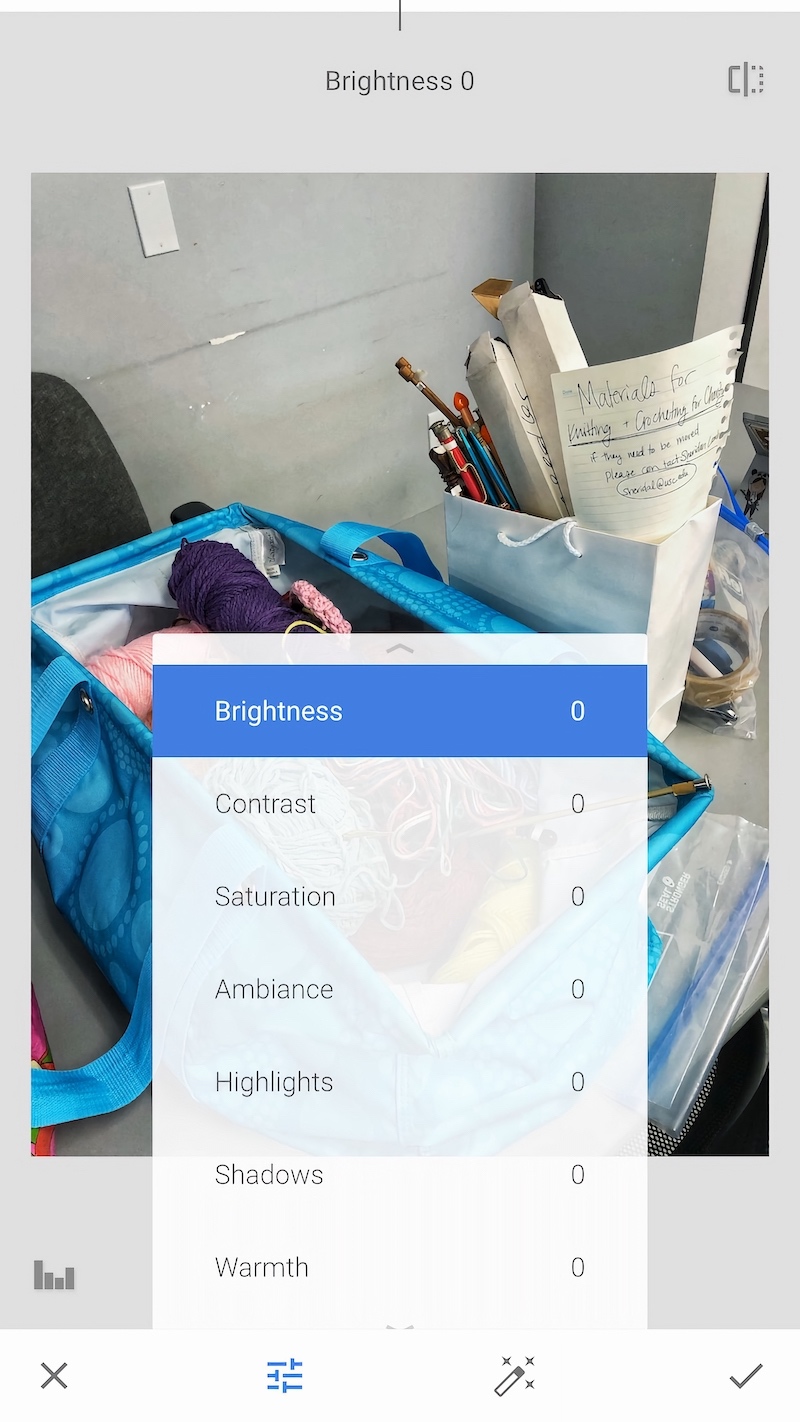
Then straight to posting we go! Sometimes, I enjoy using InstaStory to feature multiple photos rather than posting all of them in one post. I’ll also have other ambassadors or my boss texting me throughout the week asking me if I can post something to our social media handles. I love being on the go because social media is something that I enjoy partaking in.
My camera roll will end up looking like this:
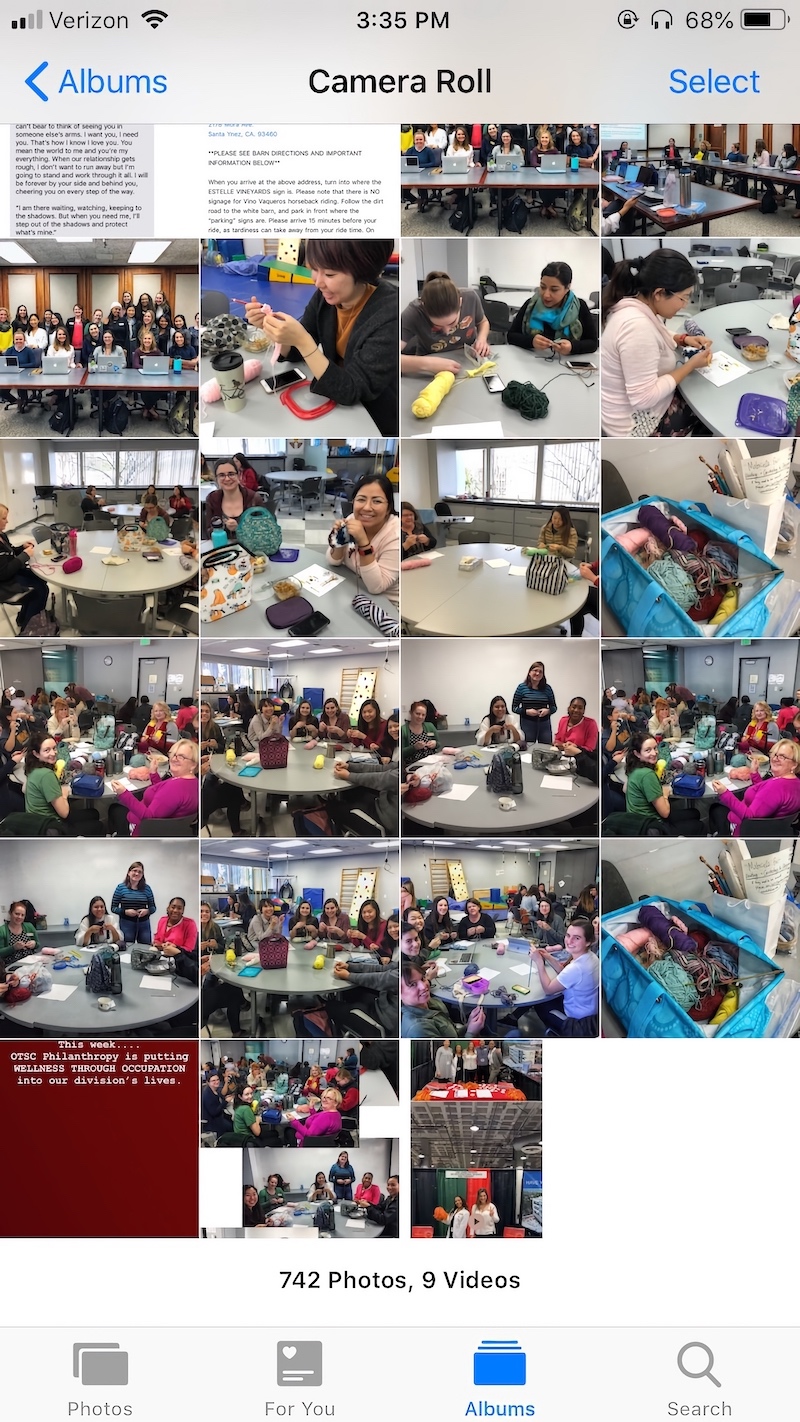
And I’ll receive messages like this LOL:
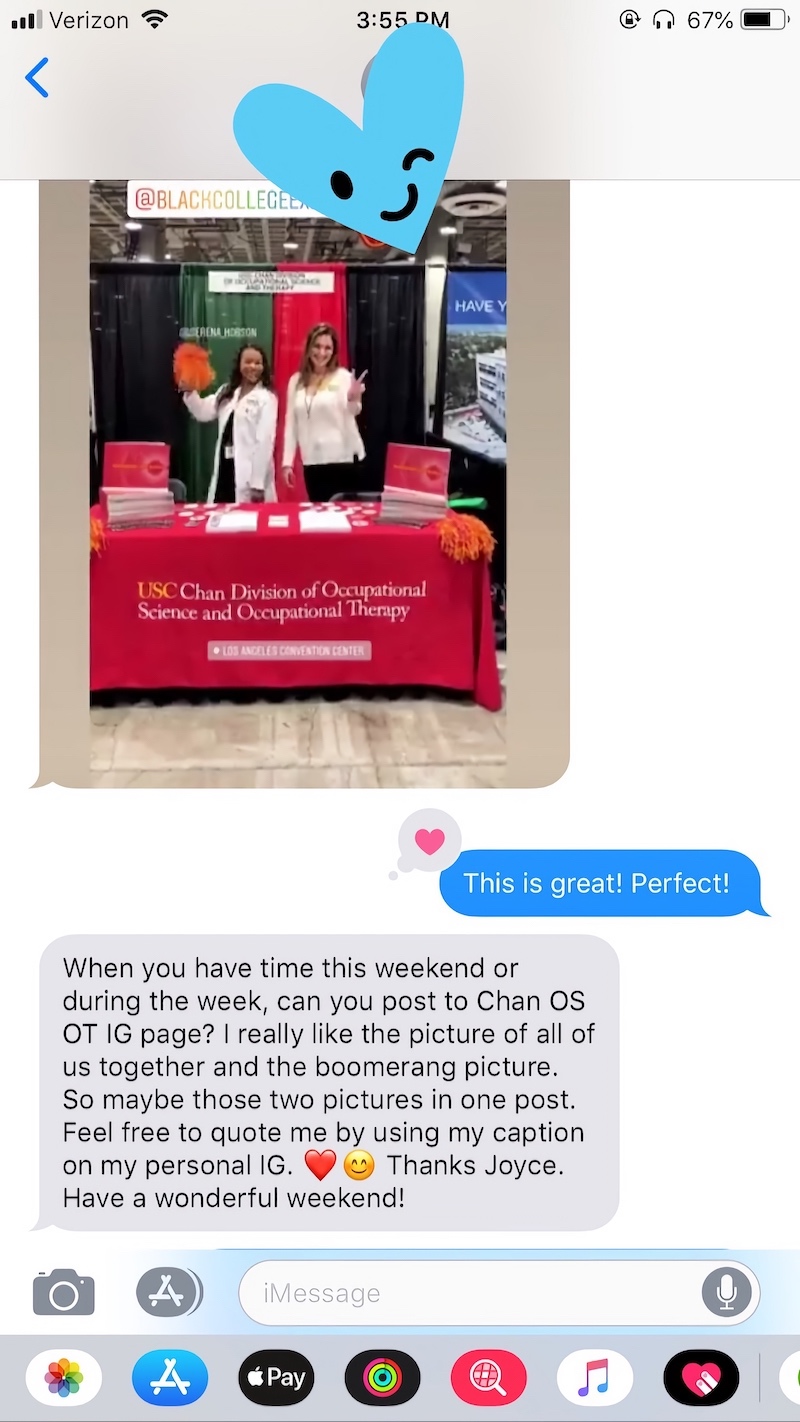
#TrojanTuesdays
For students who submitted their information and pictures to an email address and found themselves on the Chan website . . . well that’s me! I love participating in this project because I get to read a myriad of students’ journey to occupational therapy as well as fun and quirky facts about them. Our program is filled with over 100 students alone in the entry level master’s program! It’s hard to meet everyone but in this way I get to see a little snippet of the people I study with!
It’s all about the Insights
A hidden part of my social media role is pulling data from all the posts that we publish on both Instagram and Facebook. This is done mainly behind the scenes through each handle’s specific analytic software. By pulling the information, I have a clear idea of the kinds of posts that receive the most attention / likes / comments / shares. Then I can focus my energy in creating similar kinds of content!
I never thought that I could get paid to do social media stuff in OT school! It truly has been a fun journey!! Through my interaction with the official Instagram and Facebook handles, I have also been able to speak with people all over the world who are interested in our program!
⋯
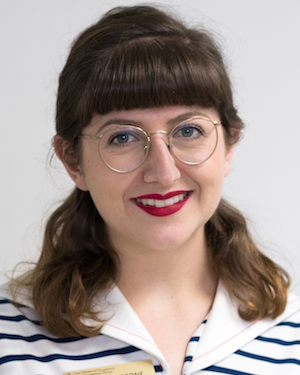
Reflections From My Residency: When did we realize that humans and animals have an emotional bond? ⟩
February 12, 2019, by Antonietta
In today’s culture, where people dress their dogs up for Halloween and get baby strollers for their cats, this may seem like a silly question . . . but when did we realize that humans can have an emotional bond with animals? The debate in “pop culture” can be traced back to 1765 when Jean-Baptiste Greuze completed an intricate portrait in oil paints of a young woman and a dead bird (see below). Each component of this painting isn’t odd for the time period, but what stirred the pot was the young woman’s expression. You can see she looks devastated. From our modern perspective, it is obvious this because her darling pet bird died, but in the mid 1700s it was not part of the zeitgeist to think animals were something you could have an emotional bond with. Jean-Baptiste Greuze observed the people around him and started to challenge this assumption with his painting.
![Greuze, J. (1765). A Girl with a Dead Canary [Painting]. Scottish National Gallery, Edinburgh, Scotland.](https://chan.usc.edu/uploads/student-blogs/antonietta-animals-humans-emotional-bond-feb2019-1.jpg)
Greuze, J. (1765). A Girl with a Dead Canary [Painting]. Scottish National Gallery, Edinburgh, Scotland.
This conversation swirled around for about a hundred years and in 1890 Paul Meyerheim added to the next iteration. He painted “The Jealous Lioness” (see below). His challenge was not only that humans and animals can have an emotional bond, but that animals actually have their own emotions. And not just simple emotions like happiness and boredom, but complex ones like jealousy. This painting illustrates the beginning of the big shift to the modern perspective of how we think about animals.
![Meyerheim, P. (1885-1890). The Jealous Lioness [Painting]. Städelscher Museums-Verein, Frankfurt, Germany.](https://chan.usc.edu/uploads/student-blogs/antonietta-animals-humans-emotional-bond-feb2019-2.jpg)
Meyerheim, P. (1885-1890). The Jealous Lioness [Painting]. Städelscher Museums-Verein, Frankfurt, Germany.
Ok, so how do I know all of this? It started one night during a conversation over dinner with my dad. I was feeling pretty beat from work and Papa asked me about my day. We had had a student at The Children’s Ranch who was struggling. He loved our animals but was not able to keep his body calm and safe around them. We had been using a tool with him, a modified zones of regulation meter, to check in with how he was feeling. It was also intended to teach him how to observe our horses and chickens to see how they were feeling. I’d brought home one of our pocket sized, laminated meters by accident and so I pulled it out and showed my dad (see below). He looked quizzical . . . “but if you’re starting the discussion with the animal’s emotions, then why are the faces emoji’s? Why not have drawings of what the horses actually look like when their emotions change?”
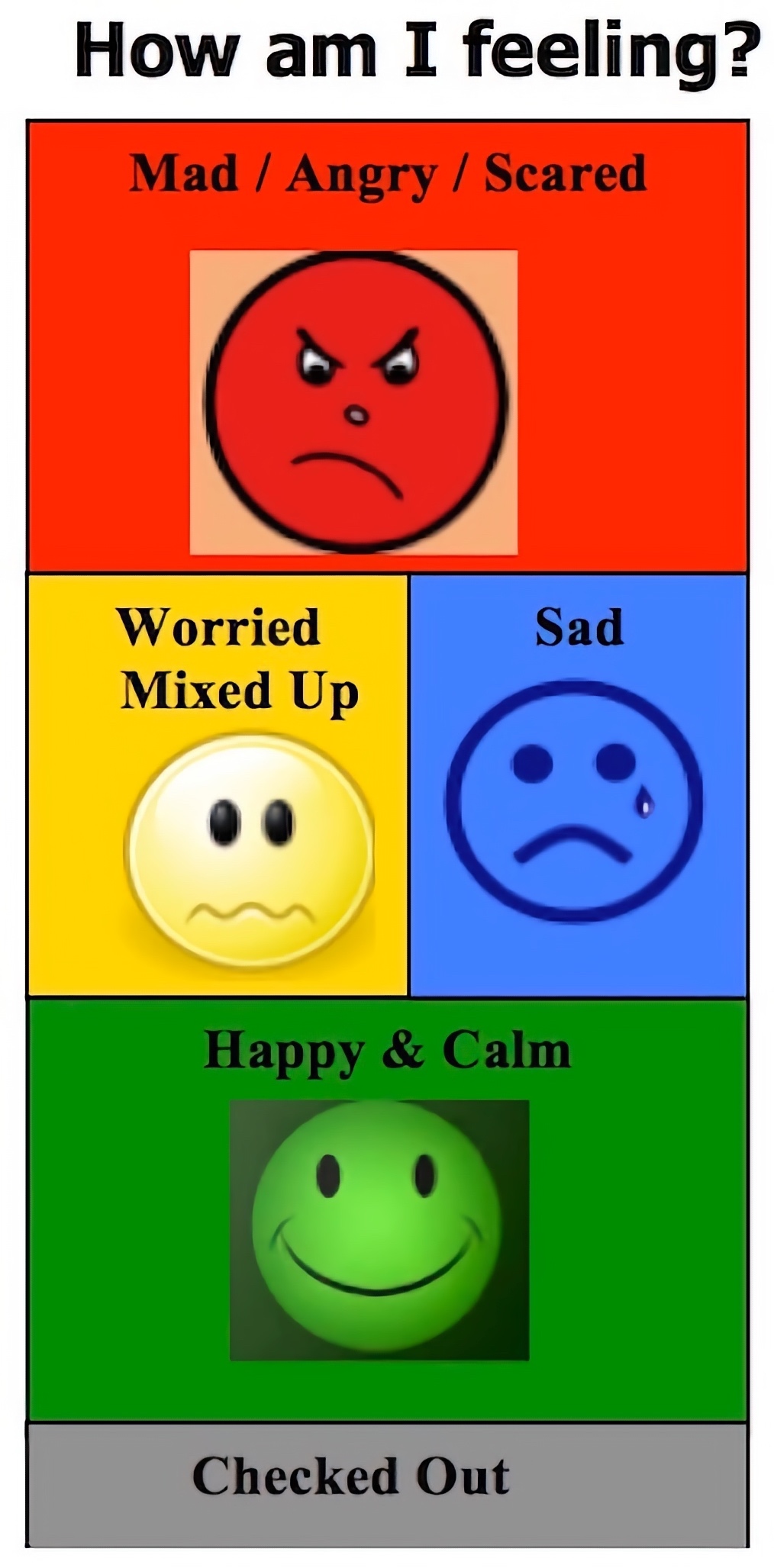
A project was born! My dad (Carmine Iannaccone) is an artist and professor in the Master of Fine Art program at Claremont Graduate University. He is the one who taught me about the two paintings in the beginning of this blog because visual culture is something he studies and is a theme he has been creating artwork around for years. He has this amazing ability to connect almost anything to visual culture, which makes our conversations fascinating and rich. So anyways, the project: a meter which features horses faces showing the different zones. Papa did the drawings, I collated and colored them in Photoshop and now we have a tool which is even more effective than the original (see below). Because humans undoubtedly do have a bond with animals, children are immediately fascinated by the horse meter. When I first show them the little card, they frequently take it right out of my hand to stare at the pictures . . . and then the questions about our horses start rolling in:
“What makes Dove sad?”
“How can I make Storm happy?”
“How can you tell that Pepper is scared?”
“Why is Cody so worried?”
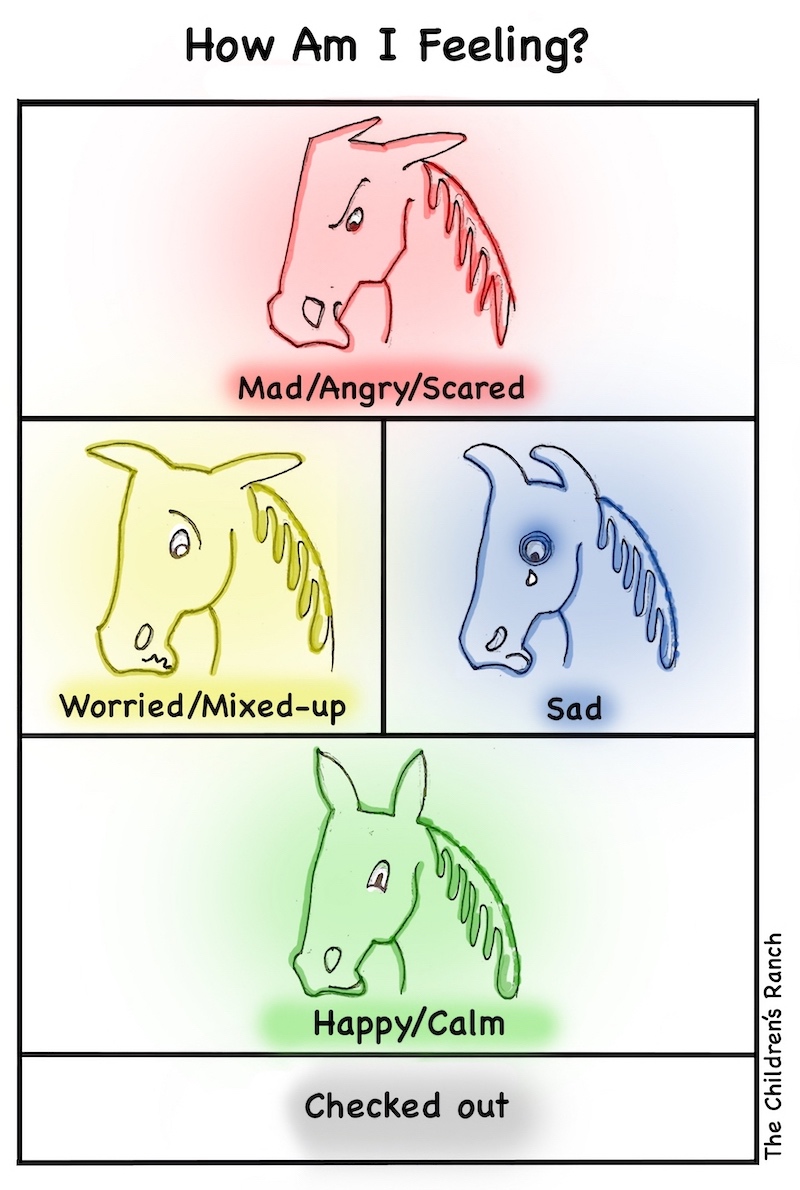
There is always buy-in. The meter flows naturally into and out of our conversations. It is a tool we use together to teach and learn about our animal companions. This collaboration with my dad continued. Inspired by the work of Greuze and Meyerheim (the painters I discussed above), he came to the Ranch every Friday for a semester . . . but more about that in my next post!
⋯

When you need supports: Ask for Help! ⟩
February 11, 2019, by Goeun
Everyone needs support when having a hard time. Especially as international students, it could be harder to find supports since we are far away from home. Before I came here, one concern that I had was where and how to get support as I don’t know anyone here and it was my first time coming to the US. I was worried about my English and I wasn’t confident whether I could do it well or not. However, since I started the Post-Professional Master’s program in the USC Chan Division of Occupational Science and Occupational Therapy, I’ve been supported by so many people and groups in school which I really appreciate.
Here are some resources where you can get help and supports when you need as an international student in the USC Chan Division of Occupational Science and Occupational Therapy.
1. Global Initiatives
When I think of supports as an international student, the first thing that came up in my mind is Global Initiatives. As its title represents, the Global Initiatives team supports international students in our Division to adapt to a new country as well as to help us academically. They’ve held Global Corner which we can join and have fun. Also, they have Academic Peer Mentors, International Student Mentorship Program and Study Hall which supports our academics and hear from previous students as well. In terms of Study Hall, Julianne, who is an Entry-Level Master’s student, help us with English when we’re having a hard time doing assignments or studying exams. I think it really helps us and makes us feel that we are being cared for.
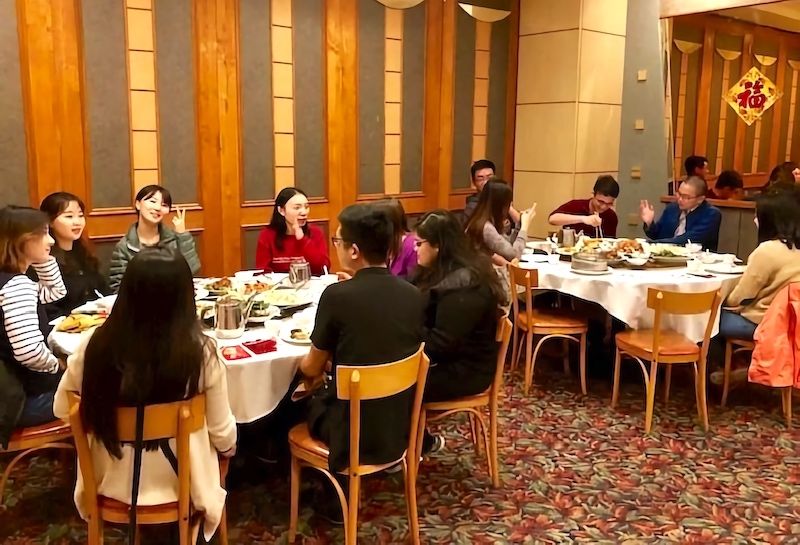
We had dinner to celebrate Lunar New Year altogether.
2. Faculty members
The Chan Division of Occupational Science and Occupational Therapy has more than a hundred faculty members. You’ll not have a chance to meet all of them, but during your program, you can get a lot of support from the faculty members. They help us not only academically, but also with other things. Dr. Blanche and Dr. Ochi, who are the program directors of the Post-Professional Master’s program, have been supporting in so many ways. We were invited to Dr. Blanche’s house for BBQ party in the first month of the program and Dr. Blanche and Dr. Ochi have been asking how have we been doing all the time. Also, Dr. Cermak, who was a professor from our program in the Fall semester, was supportive not only during the class but during the whole semester. I was surprised by how supportive they are and their willingness to help us. Also, when you have interests in some specific part, I’m sure that you can find experts and ask for advice in the Division.
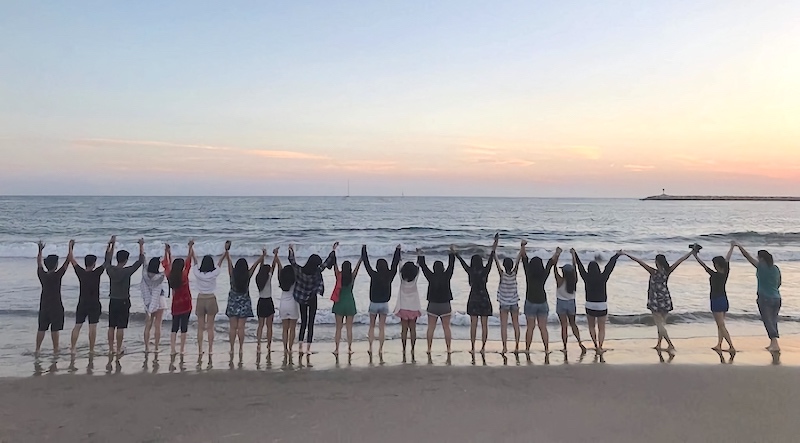
This is a picture from last semester when we went to Dr. Blanche’s house for BBQ Party.
3. Classmates
When you’re struggling with something, you may think that you’re the only person who has the problem. However, since all of your classmates from the Post-Professional Master’s program are mostly international students, they could have the same or similar problems that you have or you have been through. I was really nervous before I start the program, but once I met them in the orientation day, I could feel much better as all of my classmates were so kind and supportive. We had some group works in the Fall semester, and all of us were cooperative, helping each other. We also meet sometimes, hang out together. You can also learn so many things from different cultures to their clinical experiences as an occupational therapist in their countries. It has been really nice having them as my classmates and I’m sure if you come and start the program, your classmates will be too.
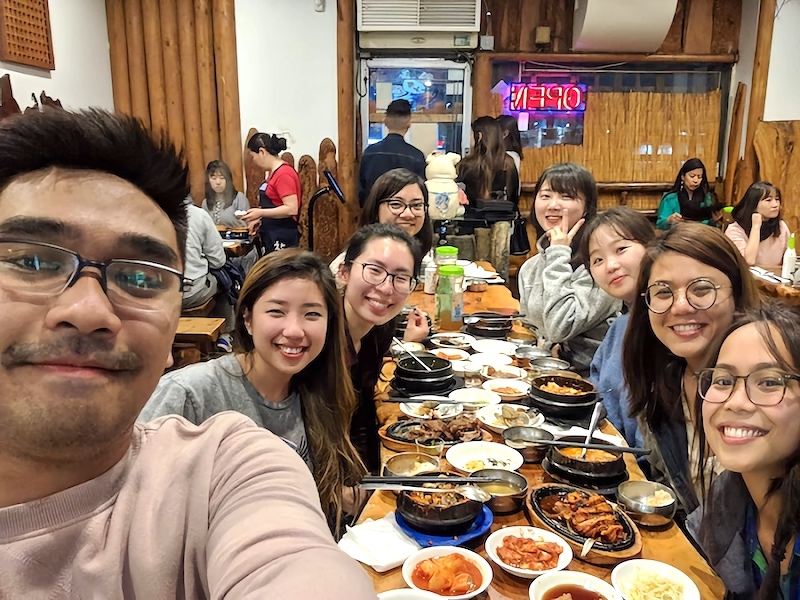
We went to Koreatown for dinner together.
4. Office of International Services (OIS)
OIS is one other support that you’ll need during your study in the U.S. Some things that you need to complete when you first come such as passport verification is done by OIS. Also, while studying, when you travel out of the States, you need OIS for a travel signature. When you’re about to graduate, you’ll need help to apply for OPT visa. Like I mentioned, OIS help us process our visa and stuff, and they have some events too like International Coffee Hour, Movie Night, and Intellectual Writing Session. You can also find some useful information on the website from broadly studying abroad to living in LA specifically.
I really appreciate their help and supports. This is one reason why I chose USC and I think it would have been more difficult studying and living in another country. Lastly, I’m also thankful for the Student Ambassadors and Admission Team since they’ve been supporting me adjust to this position.
⋯





